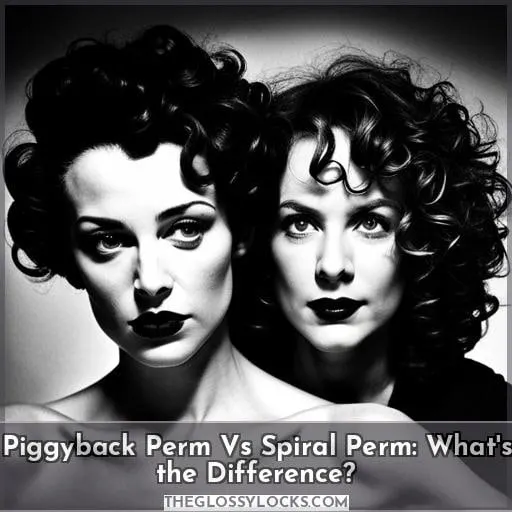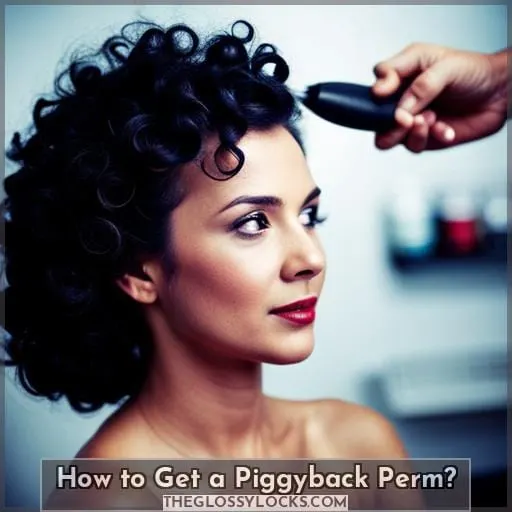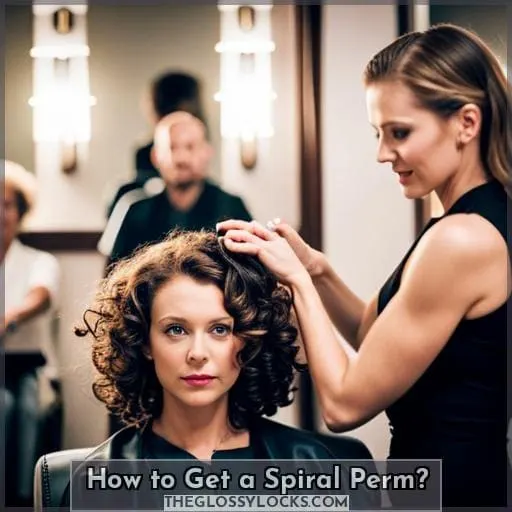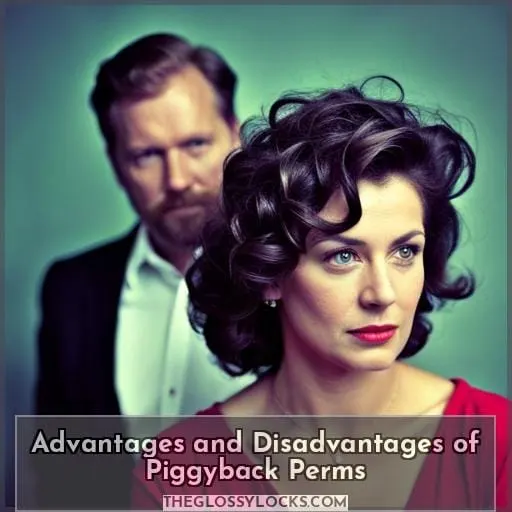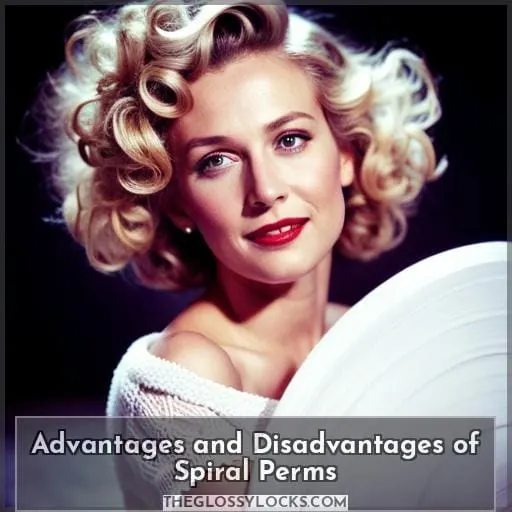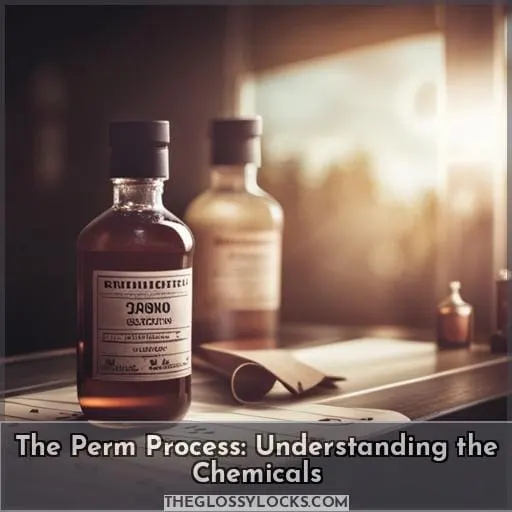This site is supported by our readers. We may earn a commission, at no cost to you, if you purchase through links.
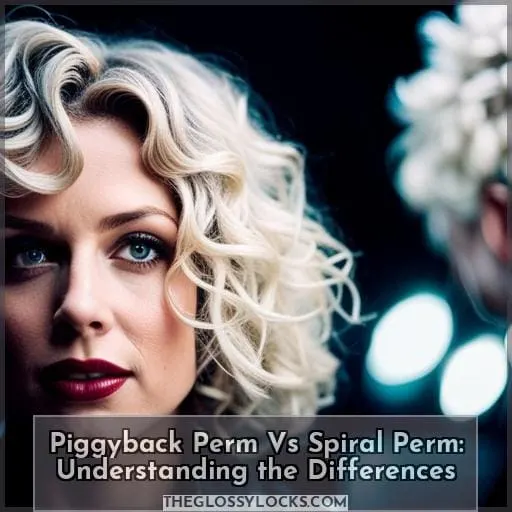 Looking to switch up your hairstyle? Curly perms are a great way to add volume and texture.
Looking to switch up your hairstyle? Curly perms are a great way to add volume and texture.
It’s important to understand the differences between these two popular styles before making a decision. In this article, we’ll break down the procedure, chemicals used, and advantages/disadvantages of each perm.
Table Of Contents
Key Takeaways
- Piggyback perms use two rods per hair segment, while spiral perms use vertically placed single rods.
- Piggyback perms create non-uniform curls with volume, while spiral perms create defined, uniform curls.
- Spiral perms tend to last longer due to their tighter curl pattern.
- Piggyback perms offer a versatile rod selection and milder chemical solutions.
Piggyback Perm Vs Spiral Perm: What’s the Difference?
So, what exactly sets a piggyback perm apart from a spiral perm?
The main differences lie in the procedure and chemicals used.
A piggyback perm involves using two rods per hair segment and wrapping the hair spirally around them to create non-uniform curls with volume.
On the other hand, a spiral perm uses vertically placed single rods to achieve tight, defined curls in a uniform pattern.
Procedure and Chemicals
The first step in understanding the differences between a piggyback perm and a spiral perm is to familiarize yourself with their respective procedures and chemicals used.
Both types of perms involve a chemical process that alters the hair’s structure, allowing for long-lasting curls or waves.
When it comes to rod selection, piggyback perms use larger rods while spiral perms utilize smaller ones.
Aftercare tips play an important role in maintaining your new hairstyle regardless of which type you choose; however, it’s worth noting that when comparing longevity between piggyback perms vs spiral perms, spirals tend to last longer due to their tighter curl pattern.
Curl Pattern and Volume
Now let’s delve into the curl pattern and volume differences between a piggyback perm and a spiral perm.
Wondering how these two perms differ in terms of their curl patterns?
- Curl Types:
- A piggyback perm creates tight, defined curls with more uniformity, while a spiral perm produces looser, cascading curls that vary in size.
- With a piggyback perm, you can achieve more structured hairstyles like ringlets or bouncy waves. On the other hand, spiral perms offer versatility for creating natural-looking beachy waves or voluminous curly styles.
- Both perms require regular moisturizing treatments to prevent dryness and frizz caused by curl interruption.
To maintain your desired look after getting either type of perming treatment done at the salon or at home:
- Use sulfate-free shampoos designed for chemically treated hair to preserve color and reduce damage.
- Apply leave-in conditioners to keep your strands hydrated throughout the day.
- Avoid excessive heat styling tools such as flat irons or blow dryers as they can cause damage over time.
For inspiration on celebrity-inspired looks using both types of perms:
Celebrities like Taylor Swift have sported beautiful spiraled locks that add movement and dimension to their hairstyle choices.
Remember that understanding each style’s unique characteristics will help you choose which one is better suited for you based on your desired outcome!
How to Get a Piggyback Perm?
To get a piggyback perm, start by choosing the right rod sizes based on your hair length and desired curl type.
It’s important to select the appropriate perm kit, preferably an alkaline one for thick and textured hair.
Section your hair into 6-9 sections or as needed for volume, then wrap small subsections of hair onto smaller rods at the roots while wrapping larger rods around the ends for that piggyback effect.
Follow this process throughout your entire head of hair to achieve natural-looking curls with body and volume.
Choosing Rod Sizes
To get a piggyback perm, you can achieve the desired curl pattern by choosing appropriate rod sizes.
The size of the rods determines the tightness or looseness of your curls.
For tighter and more defined curls, opt for smaller rods.
Larger rods will give you loose waves or soft curls.
When selecting rod sizes, consider your hair texture compatibility and styling options to achieve your desired look effectively.
Additionally, choose perm solutions that are suitable for your hair type to ensure long-lasting results with minimal damage.
For maintenance tips and further understanding on piggyback perms versus spiral perms please visit our website!
Selecting the Right Perm Kit
When selecting the right perm kit for achieving a piggyback perm, it’s important to consider factors such as hair texture and desired curl pattern.
- Choosing Rods: Different sizes of rods can create varying types of curls, so select ones that align with your desired look.
- Chemical Differences: Understand the chemical composition of the perm solutions available and choose one that suits your hair type.
- Styling Options: Consider how you want to style your hair after the piggyback perm—this will help determine which kit is most suitable.
How to Get a Spiral Perm?
To achieve a spiral perm, the key is in the sectioning and rolling technique.
You’ll want to divide your hair horizontally and vertically, using the diameter of the rod for subsections.
Roll your hair on the rod using the revolution wind method, alternating rolling directions for a natural curl pattern.
Choosing the right rod size is also important and depends on your hair length.
Sectioning and Rolling Technique
To achieve a spiral perm, you’ll need to master the sectioning and rolling technique.
This process involves dividing your hair into sections and wrapping them around rods in a specific pattern.
The rod size, rolling direction, hair length, curl pattern, and chemical process all play crucial roles in creating the desired spiral effect.
Here is an example of how the sectioning and rolling technique can be done:
| Section | Rod Size |
|---|---|
| 1 | Small |
| 2 | Medium |
| 3 | Large |
By following this methodical approach to sectioning and selecting appropriate rod sizes for each section based on your desired outcome, you can create beautiful spiral curls that last.
Remember that different hair lengths may require adjustments to ensure optimal results. Additionally, the disadvantages of spiral perms include potential damage from chemicals used during the process as well as increased maintenance requirements compared to other styling methods such as piggyback perms or natural curls.
Mastering the art of spiraling permed tresses opens up new possibilities for transforming your look with stunning texture while embracing liberation through self-expression.
Choosing the Right Rod Size
When getting a spiral perm, it’s important to regularly consider the right rod size for your hair length and desired curl effect.
Here are some key factors to keep in mind when choosing the right rod size:
- Hair Length: Shorter hair typically requires smaller rods, while longer hair can accommodate larger rods.
- Curl Type: Different rod sizes create different types of curls – smaller rods result in tighter curls, while larger rods produce looser waves.
- Hair Texture: Fine or thin hair may benefit from using smaller rods to create more volume and definition, while thick or coarse hair may require larger rods for better curl formation.
- Customization Options: Some perm kits offer a variety of rod sizes that allow you to customize your look by combining different sizes throughout your hairstyle.
- Longevity: Consider how long you want the curls to last when choosing the appropriate rod size. Smaller diameter rolls tend to provide longer-lasting results.
By considering these factors and experimenting with various perming methods and rolling techniques, you can achieve a beautiful spiral perm that suits your unique style and enhances your natural beauty without compromising on quality or damaging effects.
Advantages and Disadvantages of Piggyback Perms
Now let’s discuss the advantages and disadvantages of piggyback perms.
Piggyback perms offer a modern wave or curl pattern, providing a contemporary look to your hair.
They’re long-lasting, lasting up to 6 months, and are suitable for medium to long hair lengths.
However, it can be challenging to section and roll two rods on a single strand, making it less ideal for short hair lengths.
Advantages
One advantage of piggyback perms is that they create a modern wave or curl pattern, adding volume and body to the hair. This technique allows for more control over the placement of curls compared to spiral perms.
Another advantage is their longevity and lower maintenance requirements, as the curls tend to last longer without losing their shape.
When it comes to rod selection, piggyback perms offer versatility by allowing different sizes of rods to be used based on desired texture and curl size.
In terms of chemical comparison, piggyback perms typically use milder solutions compared to spiral perm techniques.
| Advantages | Piggyback Perm | Spiral Perm |
|---|---|---|
| Longevity and Maintenance | Curls last longer | Requires frequent touch-ups |
| Texture and Curl | Modern wave/curl | Tighter/spiral curls |
| Rod Selection | Versatile options | Limited options |
Piggyback perming offers advantages for various hair types due its ability in creating natural-looking waves or loose curls while providing a long-lasting effect with minimal upkeep needed.
Disadvantages
If you’re considering a piggyback perm, it’s important to be aware of its disadvantages.
One challenge with piggyback perms is styling. The tight curls created by this type of perm can make it difficult to achieve certain hairstyles or switch up your look.
Additionally, the maintenance required for piggyback perms can be quite high. Regular touch-ups and proper haircare are essential in order to keep the curls looking their best and prevent damage.
To overcome these challenges, consider consulting with a professional stylist for styling tips and advice tailored to your hair length and lifestyle needs.
Advantages and Disadvantages of Spiral Perms
There are several advantages and disadvantages of spiral perms that you should consider before deciding on this curling technique.
When it comes to volume vs. definition, spiral perms excel in creating tighter curls that offer more definition compared to piggyback perms. This modern curl pattern adds a trendy touch to your hairstyle, making it ideal for those who want a bold and fashionable look.
One advantage of spiral perms is the range of styling options they provide. You can experiment with different hairstyles such as updos or half-up styles while showcasing your beautiful spirals. However, one downside is the longevity factor – spiral curls tend to loosen over time compared to piggyback perm’s staying power.
Choosing the right look is crucial when considering a spiral perm since these tight curls mightn’t suit everyone’s face shape or personal style preference. It’s important to consult with an experienced stylist who can guide you in selecting the best option for you.
In summary, although there are pros and cons associated with getting a spiral perm, its ability to create defined and stylish curls can’t be denied.
The Perm Process: Understanding the Chemicals
Now let’s take a closer look at the chemical process involved in both piggyback and spiral perms.
The perm solution is responsible for breaking down the hair’s structure, while the neutralizer sets the new curl pattern and seals it in place.
Understanding these chemicals is essential to achieving desired results and ensuring lasting curls.
Perm Solution
Now let’s dive into the perm solution, a crucial part of the perm process.
The perm solution is responsible for breaking down and restructuring the hair bonds to create a long-lasting curl pattern. It’s important to choose the right type of solution based on your desired style, as this can affect factors such as longevity and maintenance.
After applying the perm solution, you’ll need to roll your hair in either piggyback or spiral formation depending on your preference. This step-by-step process ensures that you achieve beautiful curls while maintaining proper hair care practices and providing various styling options for ultimate liberation and power over your look.
Neutralize
To neutralize the hair after the perm solution has broken down its structure, you’ll need to apply a neutralizer.
This step in the perm process is crucial as it helps restore balance to your hair’s pH levels and stops any further chemical reaction.
The neutralizer works by oxidizing and fixing the new shape of your hair, ensuring that it holds its curl or wave pattern.
After applying the neutralizer, rinse thoroughly with water and follow up with a deep conditioning treatment for optimal results.
Proper aftercare tips like using sulfate-free shampoo and avoiding heat styling can also help extend your perm’s longevity.
Modern trends in perms focus on enhancing natural texture while maintaining overall hair health.
Frequently Asked Questions (FAQs)
Can I get a piggyback perm on short hair?
Yes, you can get a piggyback perm on short hair.
While it’s typically recommended for medium to long lengths, the technique can be adapted to suit shorter hair by using smaller perm rods and adjusting the rolling technique accordingly.
How long does it take to get a spiral perm?
It typically takes about 2-3 hours to get a spiral perm.
The duration may vary based on the length and thickness of your hair, as well as the expertise of your stylist.
Can I get a piggyback perm if I have thin and fine hair?
Yes, you can get a piggyback perm even if you have thin and fine hair.
The piggyback perm technique allows for customization based on different hair types and lengths, providing volume and body to your curls.
Will a spiral perm make my hair look more voluminous?
A spiral perm can add volume to your hair, creating a more voluminous look.
By using vertical rolling and square sectioning, it achieves tight and bouncy curls that give the illusion of fuller hair.
Are piggyback perms more damaging to the hair compared to spiral perms?
Piggyback perms aren’t inherently more damaging to the hair compared to spiral perms.
The potential damage depends on factors such as:
- The condition of your hair
- The expertise of the stylist
- Proper aftercare
Conclusion
To wrap up, when it comes to choosing between a piggyback perm and a spiral perm, it’s important to consider your desired outcome and personal preferences.
The piggyback perm offers versatility in rod sizes and creates a beautiful, natural-looking curl pattern.
On the other hand, the spiral perm creates more defined and uniform curls that are perfect for those seeking a bold and dramatic transformation.
Take into account the advantages and disadvantages of each style to make the best decision for your hair journey.

